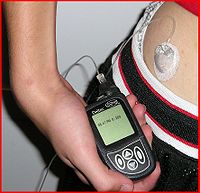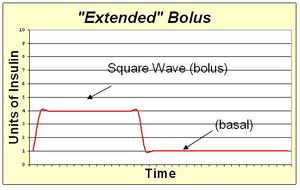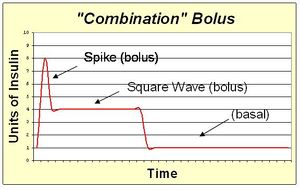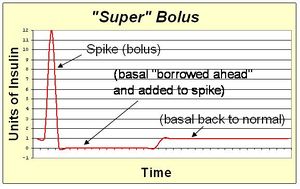مضخة الإنسولين
مضخة الأنسولين هى جهاز طبي يستخدم لإدارة إمداد الأنسولين لعلاج السكري ، المعروف أيضا باسم المستمر للأنسجة تحت الجلد علاج الانسولين بالحقن المستمر. الجهاز يشمل ما يلي :
- المضخة نفسها (بما في ذلك الضوابط ، وتجهيز وحدة نمطية ، والبطاريات)
- خزان لإستعمال مرة واحدة للأنسولين (داخل المضخة)
- نظام إدخال إبرة تحت الحلد ضمن مجموعة ، بما في ذلك قنية لإدراجها (تحت الجلد) ونظام أنابيب إلى واجهة خزان الانسولين للقنية لإيصالها إلى كانيولا.
مضخة الأنسولين هو بديل لحقن يومية متعددة من الانسولين من قبل المحاقن#ستاندرد يو 100 محاقن الانسولين أو قلم الانسولين ويسمح للعلاج بالانسولين عندما تستخدم بالاقتران مع رصد جلوكوز الدم .
. . . . . . . . . . . . . . . . . . . . . . . . . . . . . . . . . . . . . . . . . . . . . . . . . . . . . . . . . . . . . . . . . . . . . . . . . . . . . . . . . . . . . . . . . . . . . . . . . . . . . . . . . . . . . . . . . . . . . . . . . . . . . . . . . . . . . . . . . . . . . . . . . . . . . . . . . . . . . . . . . . . . . . . .
Basal rate patterns
The pattern for delivering basal insulin throughout the day can also be customized with a pattern to suit the pump user.
- A reduction of basal at night to prevent low blood sugar in infants and toddlers.
- An increase of basal at night to counteract high blood sugar levels due to growth hormone in teenagers.
- A pre-dawn increase to prevent high blood sugar due to the dawn effect in adults and teens.
- In a proactive plan before regularly scheduled exercise times such as morning gym for elementary school children or after school basketball practice for high school children.
Basal rate determination
Basal insulin requirements will vary between individuals and periods of the day. The basal rate for a particular time period is determined by fasting while periodically evaluating the blood sugar level. Neither food nor bolus insulin must be taken for 4 hours prior to or during the evaluation period. If the blood sugar level changes dramatically during evaluation, then the basal rate can be adjusted to increase or decrease insulin delivery to keep the blood sugar level approximately steady.
For instance, to determine an individual's morning basal requirement, they must skip breakfast. On waking, they would test their blood glucose level periodically until lunch. Changes in blood glucose level are compensated with adjustments in the morning basal rate. The process is repeated over several days, varying the fasting period, until a 24-hour basal profile has been built up which keeps fasting blood sugar levels relatively steady. Once the basal rate is matched to the fasting basal insulin need, the pump user will then gain the flexibility to skip or postpone meals such as sleeping late on the weekends or working overtime on a weekday.
Many factors can change insulin requirements and require an adjustment to the basal rate:
- continued beta cell death following diagnosis of type 1 diabetes (honeymoon period)
- growth spurts particularly during puberty
- weight gain or loss
- any drug treatment that affects insulin sensitivity (e.g. corticosteroids)
- eating, sleeping, or exercise routine changes
- whenever the control over hyperglycemia is degrading
- and according to the seasons.
A pump user should be educated by their diabetes care professional about basal rate determination before beginning pump therapy.
Temporary basal rates
Since the basal insulin is provided as a rapid-acting insulin, the basal insulin can be immediately increased or decreased as needed with a temporary basal rate. Examples when this is helpful include:
- During a long car drive, when more insulin is needed due to inactivity.
- During and after spontaneous exercise or sports activities, when the body needs less insulin.
- During illness or stress, when basal demand increases due to insulin resistance.
- When blood ketones are present, when additional insulin is needed.
- During menses, when additional basal insulin is needed.
Advantages of pumping insulin
- Pumpers report better quality of life (QOL) compared to using other devices for administering insulin.The improvement in QOL is being reported not only in type 1 but also in insulin requiring type 2 diabetes subjects on Pumps.[1]
- The use of rapid-acting insulin for basal needs offers relative freedom from a structured meal and exercise regimen previously needed to control blood sugar with slow-acting insulin. The alternative basal insulins, such as the long lasting insulins injected once a day, often release their insulin at a very unpredictable rate.
- Many pumpers feel that bolusing insulin from a pump is more convenient and discreet than injection.
- Insulin pumps make it possible to deliver more precise amounts of insulin than can be injected using a syringe. This supports tighter control over blood sugar and Hemoglobin A1c levels, reducing the chance of long-term complications associated with diabetes. This is predicted to result in a long term cost savings relative to multiple daily injections.[2]
- Many modern "smart" pumps have a "bolus wizard" that calculates how much bolus insulin you need taking into account your expected carbohydrate intake, blood sugar level, and still-active insulin.
- Painful neuropathy is a troublesome complication of diabetes resistant to usual treatment.There are reports of alleviation or even total disappearance of resistant neuropathic pain with the use of Insulin Pumps.[3]
- Recent studies of use of Insulin pumps in Type 2 diabetes have shown profound improvements in HbA1c,sexual performance and neuropathic pain.[4]
Disadvantages of pumping insulin
- Insulin pumps, cartridges, and infusion sets are far more expensive than syringes used for insulin injection.
- Since the insulin pump needs to be worn most of the time, pump users need strategies to participate in activities that may damage the pump, such as rough sports and activities in the water. Some users may find that wearing the pump all the time (together with the infusion set tubing) is uncomfortable or unwieldy.
- An episode of diabetic ketoacidosis may occur if the pump user does not receive sufficient fast acting insulin for many hours. This can happen if the pump battery is discharged, if the insulin reservoir runs empty, the tubing becomes loose and insulin leaks rather than being injected, or if the cannula becomes bent or kinked in the body, preventing delivery. Therefore pump users typically monitor their blood sugars more frequently to evaluate the effectiveness of insulin delivery.
- Possibility of insulin pump malfunctioning, and having to resort back to multiple daily injections until a replacement becomes availablable








